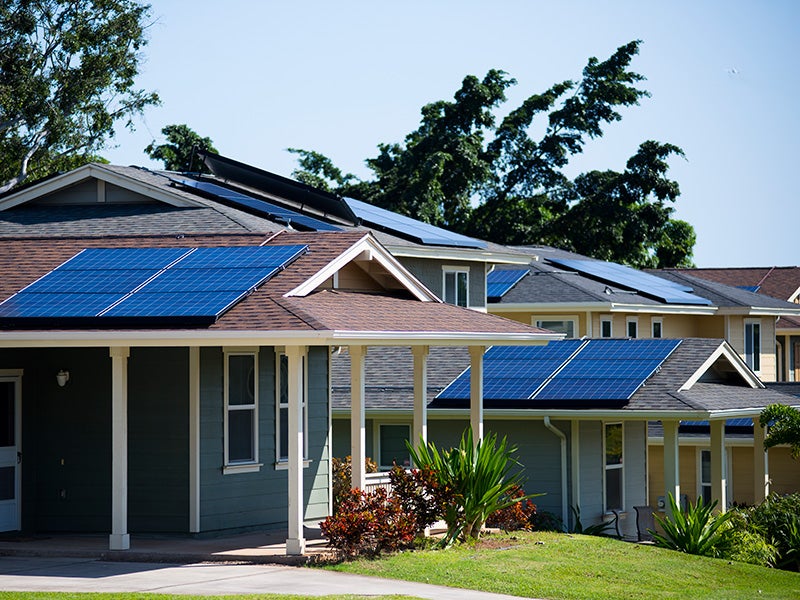Clean Energy Advocates Commend Hawai‘i Utility Commission’s Latest Rooftop Solar Decision
Victory
—New “smart export” program offers first step toward next generation of solar-plus-battery systems
Contact
Last Friday afternoon, the Hawaiʻi Public Utility Commission (PUC) issued a major order opening a path for the future of “distributed energy resources” (DER) like rooftop solar in Hawaiʻi, including the next generation of DER incorporating solar and batteries. Among the many rulings in its 194-page order, the PUC established two new programs for rooftop solar in Hawaiʻi, including a “smart export” program that allows customers an opportunity to store solar energy during peak sun hours and provide energy to the grid at later times, when demand on the grid is higher. This “smart export” option is a first step toward a future in which customer-owned DER can more dynamically interact with the grid and further contribute to building a cleaner, less costly, and more resilient electric system.
“This PUC order is a ray of light for rooftop solar customers and businesses in Hawaiʻi,” said Earthjustice attorney Isaac Moriwake, who represents Hawaiʻi Solar Energy Association (HSEA), the state’s largest solar industry group, in the ongoing PUC proceeding. “The market has been in a cloudy limbo for several years, but this order starts opening a path forward and signals Hawai‘i is still ‘open for business’ for the future of DER.”
The PUC order concluded a nine-month process in which DER industry and clean energy advocacy parties (DER parties) deliberated with the Hawaiian Electric utilities (HECO) on a range of issues and presented the points of dispute to the PUC for resolution. The PUC’s order supported many of the DER parties’ positions and proposals to allow customers to add more rooftop solar on the grid.
The PUC summarized its order as “the next evolutionary step toward reaching the long-term vision of a robust DER market, offering customers a variety of options to manage electricity use and provide support to the grid.” The programs it established will serve as “foundational building blocks, upon which additional grid service options can be layered,” which will give “customers choice and flexibility.”
DER parties originally proposed the “smart export” concept in January of this year. After months of negotiations with HECO yielded very few areas of agreement on the details, the PUC took the lead in finalizing the structure and terms of the program in its order.
While participation in the smart export program may as a practical matter require the installation and use of batteries, the PUC also opened another program called “Customer Grid Supply Plus” (CGS+), which allows customers to install solar-only systems, provided that they allow the utility to install controls to shut off the systems under certain circumstances to preserve grid reliability. The original CGS program that the PUC created in 2015 was set to expire today, but the PUC’s order allowed that program to continue until its remaining capacity is filled.
One aspect of the PUC’s order that raised concerns is the compensation rates it set for energy exported to the grid, which are bare minimum amounts based only on very short-term utility energy costs. This understates the full value of the clean energy that DER provide to the grid and society over the long term. The PUC, however, indicated that DER customers may be given additional opportunities to receive compensation for “grid services,” which may be developed in the next process in the DER proceeding.
“We appreciate the PUC providing the Hawaiʻi market more direction, stability, and running room in the near term,” said Rick Reed, President of HSEA. “We need to keep on working so that rooftop solar customers can be fully compensated for all the benefits they provide to the grid and the people of Hawaiʻi.”
In another key aspect of its order, the PUC required the activation of certain “advanced inverter” functions, which are technological capabilities of DER systems to regulate their power output to maintain grid stability. DER parties supported activation of these functions, except for one voltage support function that threatened substantial reductions in power production if the utility did not adequately monitor and maintain voltage conditions on its grid. The PUC agreed with DER parties that more work was needed before HECO could require all customers to activate that voltage support function, and also that customers should be compensated for providing such grid services.
“Advanced inverter functions will enable customer-installed DER to be key building blocks for the grid, where a fleet of systems can combine to become the ‘virtual power plants’ of the future,” said Steven Rymsha, an engineer and spokesperson for The Alliance for Solar Choice. “But the utility of the future needs big-picture vision and planning to efficiently coordinate these and other tools for maximum benefits to customers and the grid.”

Additional Resources
About Earthjustice
Earthjustice is the premier nonprofit environmental law organization. We wield the power of law and the strength of partnership to protect people's health, to preserve magnificent places and wildlife, to advance clean energy, and to combat climate change. We are here because the earth needs a good lawyer.